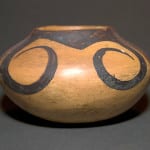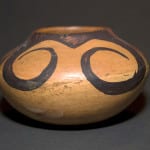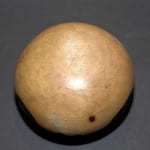The splotchy red paint suggests a production date before 1930; I originally estimated 1910 to 1920. The Blairs (1999:92-93) point out that this eagle feather design is characteristic of Nampeyo’s work and is considered as “owned” by her family (as in Nampeyo’s seedpot 2005-16). While the design of 2005-16 is one of the simplest renditions of this design known, the design on 2006-15 is even more elemental. There are only two design elements on 2006-15, each a solid color and each repeated twice, yet the contradictory tensions evident in the more elaborate design of 2005-16 are well represented here, and there is a use of negative space to highlight the design.. Moreover, the design is perfectly adapted to the shape of the pot, as on 2005-16. (See the extensive discussion of tNampeyo’s design strategies in Appendix B.)
Although small in size, the visual impact of the pot is powerful. Wyckoff (1983:73) distinguishes between Sikyatki Revival Polychrome “Style A” and “Style B.” “Style A” was produced from about 1900 to 1930, when it came under attack by the good folks at the Museum of Northern Arizona. “Style A” is characterized by color: “the red and black are more ‘dense’ and the red is ‘muddy’”—more so than on prehistoric ware or later “Style B” pots. This seed jar would seem to be a classic example of a “Style A” pot because of its inky-black and dense muddy red coloring. With the establishment of the Hopi Show in 1930, the Coltons at the Museum of Northern Arizona were able to encourage the use of less intense and less muddy paints and “Style B” was born.
Dwight Williams, a Nampeyo scholar, trader, and eBay friend, was the under bidder on the pot. He describes 2006-15 as “quickly but deftly painted” in the “loose painting style” used by Nampeyo on tourist pieces between 1900 and 1920. His description captures the spirit of this small, elegant, and powerful pot.
Several years after Dwight Williams’ comments, Steve Elmore (in Santa Fe, October 2009) offered a larger (4” h X 7” w) but very similar seedpot for sale and identified it as “by Nampeyo” and dated it as c. 1910. (Photograph on file.) The design, paint color, and surface finish of the two pots are close to identical. I am not yet convinced 2006-15 is by Nampeyo, but I am confident that this pot and the one offered for sale by Steve Elmore were produced by the same artist.
On November 19-20, 2009 my nephew David Alexander and I were guests of Ed Wade and his wife Carol in their Sedona home. During this time Ed looked at 2006-15 on-line and suggested a startling origin for pot 2006-15. The shape of the pot indicates that it was formed by Nampeyo, he believes. Ed agrees with the Blairs: the design indicates a Nampeyo family painter. However, he suggests, the painter is not Nampeyo, but her youngest daughter Fannie.
Fannie was probably born about 1900. Ed dates pot 2006-15 as made about 1915 to 1918. This is a a bit later than Steve Elmore’s estimate for his pot (c. 1910) but well within a margin of reasonal difference for informed estimates of age. Ed points to the uneven junctions between the black and red designs, the somewhat awkward formation of the empty space formed by the black “tails” and the red lobes that are of uneven shape and length. Nampeyo, he believes, would never have produced such sloppy and awkward painting. Rather, he suggests, Nampeyo was using the pot to teach her inexperienced youngest daughter how to paint a classic family design. If Ed’s intuition is correct, jar 2006-15 would be one of the earliest examples of Fannie’s painting known. A few days later I was talking with Bruce McGee at the Heard Museum. I had not mentioned this jar to him when, he noted that Fannie had not begun paining pottery until she was about 14, thus independently confirming both Ed Wade’s estimate of the production date and the possibility that this was a learning pot for Fannie.
There is no definitive characteristic that directly points to Nampeyo as the maker or Fannie as painter. Any attribution of Nampeyo as the maker or Fannie the painter must remain highly tentative. Once again, Marti Struever’s classification (Cusick 1984:7) seems appropriate: I would judge 2006-15 as “possibly by Nampeyo, or made in her style” since “judgments determined by the appearance of known design motifs and compositions leaves some doubt as to whether the unit was done by (Nampeyo) or someone reproducing the Nampeyo style.”
The Blairs (1999:XVI, fig 3.22) show a photograph of a Polacca polychrome jar, ca. 1850 –1900 with a particularly simple rendition of the eagle design that is similar to pot 2006-15. My guess is that pot 2006-15 is just a few years younger than that Polacca pot.
The Museum of Northern Arizona has a seedpot that in form, design, and spirit is very much like pot 2006-15. While the design of the MNA pot is somewhat more elaborate that the pot in this collection, the museum pot also has a very simple motif. The lightly-drawn curvilinear “wings” on the two pots seem identical, as does the overall feel of the pot. Maker “unknown,” the Museum estimates that their pot was produced in the 1880-1920-time period (Allen, 1984:51 and 102).







